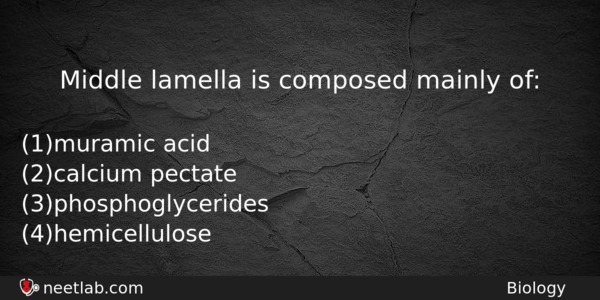| ⇦ | 
| ⇨ |
Middle lamella is composed mainly of:
Options
(a) muramic acid
(b) calcium pectate
(c) phosphoglycerides
(d) hemicellulose
Correct Answer:
calcium pectate
Explanation:
Middle lamella is mainly composed of calcium pectate. Calcium is deposited in plants cell walls during their formation it is required for the stability and function of cell membranes and acts as a type of ‘cementing agent’ in the cell walls in the form of calcium pectate’. Calcium pectate is like a glue binding adjacent cells together so if inadequate calcium is not transported during cell formation, tissues become less stable and prone to disintegration.
Related Questions: - Increase in circumferance of stem is due to the activity of
- Photophosphorylation was discovered by
- Which is not correctly matched for organism and its cell wall degrading enzyme?
- Importance of day length in flowering of plants was first shown in
- How many ribs are present in human beings
Question Type: Memory
(964)
Difficulty Level: Easy
(1008)
Topics: Cell Structure and Functions
(413)
Subject: Biology
(4253)
Important MCQs Based on Medical Entrance Examinations To Improve Your NEET Score
- Increase in circumferance of stem is due to the activity of
- Photophosphorylation was discovered by
- Which is not correctly matched for organism and its cell wall degrading enzyme?
- Importance of day length in flowering of plants was first shown in
- How many ribs are present in human beings
Question Type: Memory (964)
Difficulty Level: Easy (1008)
Topics: Cell Structure and Functions (413)
Subject: Biology (4253)
Important MCQs Based on Medical Entrance Examinations To Improve Your NEET Score
18000+ students are using NEETLab to improve their score. What about you?
Solve Previous Year MCQs, Mock Tests, Topicwise Practice Tests, Identify Weak Topics, Formula Flash cards and much more is available in NEETLab Android App to improve your NEET score.
Share this page with your friends

Leave a Reply